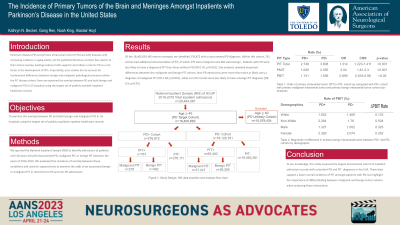The Incidence of Primary Tumors of the Brain and Meninges Amongst Inpatients with Parkinson's Disease in the United States
Friday, April 21, 2023


Kathryn N. Becker, PhD (she/her/hers)
Medical Student
The University of Toledo College of Medicine
Toledo, Ohio, United States
ePoster Presenter(s)
Introduction: Parkinson disease (PD) and primary intracranial tumors (PITs) are both diseases with increasing incidence in aging adults, yet the published literature contains few reports of their clinical overlap. Existing evidence both supports and refutes a role for PD as a risk factor in the development of PITs. Importantly, prior studies do not account for fundamental differences between benign and malignant pathological processes within the PIT disease cohort. Here we examined the overlap between PD and both benign and malignant PITs in US hospitals using the largest set of publicly available inpatient healthcare records.
Methods: We queried the National Inpatient Sample (NIS) to identify admissions of patients over 40-years-old with documented PD, malignant PIT, or benign PIT between the years of 2016-2019. We evaluated the incidence of overlap between these conditions and used chi-squared tests to examine the odds of an associated benign or malignant PIT in records from PD and non-PD admissions.
Results: Of the 18,405,663 NIS entries reviewed, we identified 276,872 with a documented PD diagnosis. Within this cohort, 761 entries had additional documentation of PIT, of which 279 were malignant and 482 were benign. Patients with PD were less likely to have a diagnosed PIT than those without PD [OR 0.76; p< 0.001]. Sub-analyses revealed important differences between the malignant and benign PIT cohorts. Non-PD admissions were more than twice as likely carry a diagnosis of malignant PIT [OR 2.04; p< 0.001], while non-PD records were less likely to have a benign PIT diagnosis [OR 0.9; p< 0.05].
Conclusion : To our knowledge, this study assessed the largest documented cohort of inpatient admission records with coincident PD and PIT diagnoses in the USA. These data support a lower overall incidence of PIT amongst patients with PD, but highlight the importance of differentiating between malignant and benign tumor cohorts when analyzing these interactions.
Methods: We queried the National Inpatient Sample (NIS) to identify admissions of patients over 40-years-old with documented PD, malignant PIT, or benign PIT between the years of 2016-2019. We evaluated the incidence of overlap between these conditions and used chi-squared tests to examine the odds of an associated benign or malignant PIT in records from PD and non-PD admissions.
Results: Of the 18,405,663 NIS entries reviewed, we identified 276,872 with a documented PD diagnosis. Within this cohort, 761 entries had additional documentation of PIT, of which 279 were malignant and 482 were benign. Patients with PD were less likely to have a diagnosed PIT than those without PD [OR 0.76; p< 0.001]. Sub-analyses revealed important differences between the malignant and benign PIT cohorts. Non-PD admissions were more than twice as likely carry a diagnosis of malignant PIT [OR 2.04; p< 0.001], while non-PD records were less likely to have a benign PIT diagnosis [OR 0.9; p< 0.05].
Conclusion : To our knowledge, this study assessed the largest documented cohort of inpatient admission records with coincident PD and PIT diagnoses in the USA. These data support a lower overall incidence of PIT amongst patients with PD, but highlight the importance of differentiating between malignant and benign tumor cohorts when analyzing these interactions.
